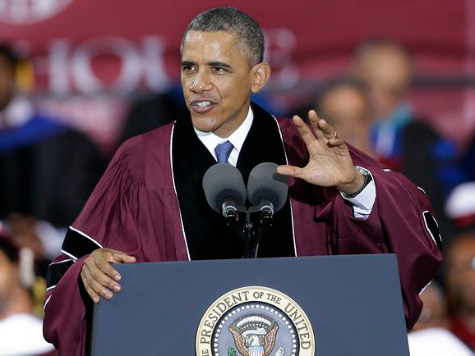From state academic standards and tests to charter and virtual schools, the K-12 education world has changed in the 30 years since President Ronald Reagan’s landmark “A Nation at Risk” commission diagnosed the myriad problems with public schooling in America. However, with their eagerness to federalize what has always been a state and local responsibility, advocates for national English and math standards known as Common Core don’t seem to have learned anything in the intervening decades.
One lesson that might have been learned is that state-based models produce better results than top-down initiatives that originate in Washington. It should come as no surprise; state and local taxpayers fund 90 percent of K-12 education and have far more invested in their schools than do federal bureaucrats or D.C.-based education lobby groups.
Had the Beltway forces behind Common Core, including the Obama administration, the Bill & Melinda Gates Foundation, National Governors Association, Council of Chief State School Officers, and Achieve, Inc., been interested in improving students’ academic performance, they would have looked to Massachusetts’s success.
In the early 1990s, Massachusetts was an unremarkable performer on the National Assessment of Educational Progress (NAEP) and SATs. However, in the wake of landmark 1993 education reform legislation, state SAT scores rose for 13 consecutive years. In 2005, Massachusetts students became the first to score best in the nation in all grades and categories on the NAEP assessments. Since then, they have repeated the feat each time the tests have been administered.
While U.S. students lag behind their international peers, the Bay State’s eighth graders tied for best in the world in science in the 2007 Trends in International Math and Science Study. Massachusetts has truly responded to the alarm sounded by “A Nation at Risk.”
Yet strategies embraced by Common Core’s proponents are the opposite of those that worked in Massachusetts. The Bay State’s success was based on a golden triangle of rigorous academic standards, the high quality tests students must pass to graduate from high school, and teacher testing all aligned to the same liberal arts-rich content.
Common Core, on the other hand, recycles top-down policies. Its roots can be traced to a letter written to Hillary Clinton by Marc Tucker, president of the National Center on Education and the Economy, after President Bill Clinton’s 1992 election. The letter laid out a plan “to remold the entire American system” into a centralized one run by “a system of labor market boards at the local, state and federal levels” where curriculum and “job matching” will be handled by government functionaries “accessing the integrated computer-based program.”
Today, many national standards advocates still embrace these same anti-academic impulses despite two decades of evidence to the contrary.
In 1998, Connecticut had higher reading scores than Massachusetts. Yet just as the Bay State was adopting clearly articulated academic goals, Connecticut opted for a skills-based workforce development approach. By 2005, Massachusetts’s scores had jumped dramatically, while Connecticut was one of seven states that experienced outsized drops in reading scores.
Compared to Massachusetts’s former English standards, Common Core reduces classic literature, poetry, and drama by 60 percent. It ignores the works of Charles Dickens, Edith Wharton, Arthur Conan Doyle, and novels like Mark Twain’s Huckleberry Finn. The change is fatal because literary vocabulary is of far higher quality than what is in the “informational texts” Common Core favors.
In math, Common Core delays the progression to algebra I – the gateway to higher math study – by at least a year. Stanford University Emeritus Mathematics Professor R. James Milgram, the only academic mathematician on Common Core’s validation committee, refused to sign off on the final draft, describing the standards as having “extremely serious failings” and reflecting “very low expectations.”
Common Core’s problems aren’t just academic. It was adopted using a process which bypassed the state legislatures that fund American K-12 education.
In 2011, after 45 states had already adopted the standards, Pioneer Institute commissioned the first independent study of how much it will cost states to transition to Common Core. The study pegged the price tag at $16 billion.
Most disturbing are serious questions about Common Core’s legality. The 1965 Elementary and Secondary Education Act, which defined the federal government’s limited role in K-12 education; the 1970 General Education Provisions Act; and the 1979 law establishing the U.S. Department of Education (USED) all explicitly prohibit the federal government from funding, directing, validating, or controlling any nationalized standards, testing, or curriculum.
Yet Race to the Top, a federal education grant competition that dangled $4.35 billion in front of states, favored applications that adopted Common Core. The USED subsequently awarded $362 million to fund two national testing consortia to develop nationalized assessments and a “model curriculum” that’s “aligned with” Common Core. In his February State of the Union speech, President Barack Obama took full credit for Common Core’s D.C.-led uniformity.
Several states, like Texas, Virginia, and Nebraska, opted out of Common Core. Anti-Common Core movements have sprung up in a majority of the remaining states, and what began at the grassroots is now making its way to state legislatures. Last April, the Republican National Committee passed forceful anti-Common Core resolutions.
Public education has largely languished in the U.S. because pursuit of an ever more centralized bureaucracy trumps academic excellence and parental choice. Neither the federal government nor the D.C. groups behind Common Core can point to a single program they have advocated for that remotely approaches Massachusetts’s student achievement results. It’s hardly the first example of ignoring facts and exceeding federal authority in support of a domestic policy agenda over which states rightfully have jurisdiction.
Jamie Gass directs the Center for School Reform and Charles Chieppo is a senior fellow at Pioneer Institute, a Boston-based think tank.

COMMENTS
Please let us know if you're having issues with commenting.